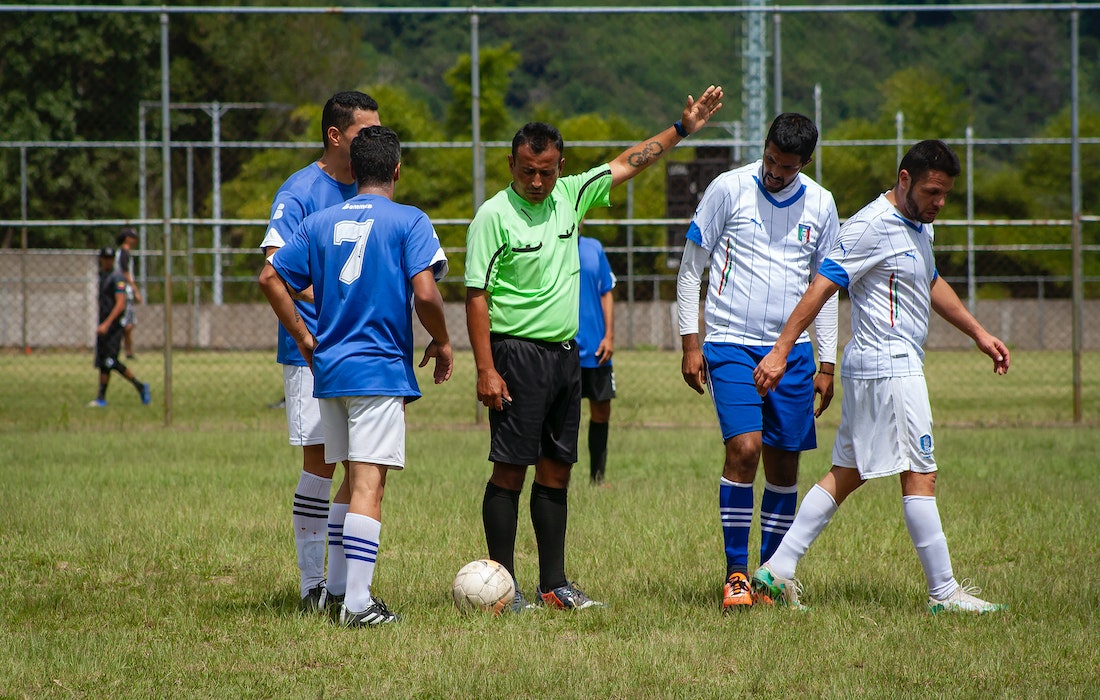Soccer stands as one of the most popular and widely followed sports globally. Its appeal transcends cultural boundaries, drawing together fans from all walks of life. The magnitude of its popularity was vividly demonstrated in 2022, with the Qatar World Cup captivating a staggering global audience of 1.5 billion, underscoring the sport’s unrivaled influence and reach.
In this sport, rules play a pivotal role in maintaining order and upholding the integrity of the competition. Among these rules, the issuance of a red card holds a distinctive place. Understanding the implications of a red card in soccer is crucial for players to avoid jeopardizing their team’s chances and for fans to grasp the pivotal moments that can shift the course of a game.
This article will explore the significance of this disciplinary action and explain the connections between players and fans to the game’s heartbeat.
What is a Red Card?
In soccer, referees employ a system of colored cards to communicate their decisions, with a red card holding a particularly weighty significance. When a player gets shown a red card, it signifies that they have committed a grave infraction or misconduct on the field, an offense that goes beyond the boundaries of acceptable play.
This card serves as a clear indication to players, officials, and spectators that the player in question must leave the field immediately. With a red card in hand, the player’s team is forced to continue the match with one less player, often creating a significant disadvantage in terms of numerical strength and strategic positioning.
When Do Soccer Players Get a Red Card?

Soccer players receive a red card when they commit serious fouls or engage in misconduct that significantly disrupts the flow and fairness of the game. A red card serves as a disciplinary measure to maintain the sport’s integrity and ensure players adhere to established rules.
Common scenarios warranting a red card include violent behavior, such as striking an opponent, spitting, or physical altercations. Players can also be sent off for denying an opponent a clear goal-scoring opportunity through a deliberate handball or foul or using offensive language or gestures. Additionally, accumulating two yellow cards in a single match leads to a red card dismissal.
The issuance of a red card not only removes the player from the ongoing match but often results in suspensions for subsequent games. Referees must carefully assess the severity and impact of the infraction before brandishing the red card, as its implications are profound – reducing the offending team’s numerical strength and dramatically influencing the game’s dynamics.
10 Offenses That Lead to Red Card
Understanding the infractions that lead to a red card is essential for players, coaches, and fans. Some of the most common examples of offenses that earn a player an immediate red card dismissal are as follows:
- Violent Conduct: One of the most blatant red card offenses in soccer is violent conduct, which refers to deliberate actions such as striking, punching, or kicking an opponent. These acts are strictly prohibited, regardless of whether they result in injury. The use of excessive force, even in the heat of competition, can lead to immediate ejection from the match, jeopardizing the player’s team and potentially altering the outcome of the game. Players need to maintain discipline and respect for the rules to ensure fair play and a safe environment for all participants.
- Dangerous Tackles: Reckless and dangerous tackles that endanger the safety of opponents are grounds for a red card. A tackle from behind, with studs showing from the soccer cleats, or one that targets an opponent’s legs in an attempt to harm them can result in expulsion. Intent is not always necessary; the severity of the tackle and the potential to cause injury are vital considerations.
- Denying a Goal-Scoring Opportunity: Players who deliberately deny their opponents a clear goal-scoring opportunity through an intentional handball or foul can expect to receive a red card, which signifies their dismissal from the match. This rule applies not only to outfield players but also to goalkeepers who handle the ball outside their designated area. By committing such an offense, the player not only robs the opposing team of a promising chance to score but also disrupts the balance and fairness of the game. Therefore, referees respond promptly and decisively with a red card to maintain the integrity and equality of the sport.
- Serious Foul Play: Engaging in serious foul play, such as recklessly lunging into tackles with excessive force, can result in a red card being shown. Actions that put opponents at unnecessary risk or cause injury, irrespective of intent, are considered entirely unacceptable on the field. Players are expected to compete wholeheartedly for the ball while prioritizing the safety and well-being of their fellow players.
- Offensive Language or Gestures: Soccer demands respect not only for the rules but for fellow players, officials, and spectators. The use of offensive language or gestures can result in a red card. Insults or gestures that incite anger or provocation have no place on the field.
- Spitting: Spitting at opponents or any other individuals on the field is a repugnant offense that warrants an immediate red card. This behavior not only reflects poor sportsmanship but also undermines the principles of respect and fair competition.
- Second Yellow Card: Accumulating two yellow cards in a single match translates into a red card. Referees show yellow cards for minor infractions, such as reckless tackles or dissent towards officials. When a player receives two yellow cards within the same game, it demonstrates a pattern of misconduct that not only leads to ejection but also reflects a lack of discipline. This highlights the significance of maintaining composure and adhering to the rules throughout the entirety of the game, as any lapse in discipline can have severe consequences for both the player and the team.
- Violent Behavior towards Officials: Referees and other match officials must be treated with respect. Any display of violent behavior, including pushing, shoving, or aggressive gestures toward officials, can result in a red card. Ensuring a safe and respectful environment for everyone involved is of paramount importance.
- Racial or Discriminatory Abuse: Soccer, as a sport, has always been at the forefront of promoting inclusivity and diversity. It embraces individuals from all walks of life, regardless of their race, ethnicity, or background. Any form of racial or discriminatory abuse is not only strongly discouraged but vehemently condemned. To ensure a fair and respectful playing environment, players found guilty of such behavior face the ultimate consequence: a red card. This disciplinary action reflects the unwavering commitment of soccer to foster a truly welcoming and harmonious atmosphere for everyone involved.
- Leaving the Field without Permission: Exiting the field without the referee’s permission, especially in a fit of anger or protest, can lead to a red card. While players are permitted to leave the field during substitutions, doing so in an aggressive or unsportsmanlike manner can result in disciplinary action.
What Happens If a Player Gets a Red Card?

Receiving a red card in soccer is a significant event with immediate and lasting consequences for the player and their entire team. Issuing a red card signifies a severe breach of the game’s rules and sportsmanship standards, resulting in cascading effects that impact both the current match and future games. Here are the key implications of a red card:
- 1. Immediate Exit from the Field: When a player is shown a red card, they must leave the field of play immediately. This exit is often accompanied by a walk of shame towards the sidelines, with the player’s departure being a clear indication to everyone present that they have committed a serious offense.
- No Replacement: Unlike yellow cards, which serve as warnings, red cards do not allow for a substitution. The dismissed player cannot be replaced by a substitute, leaving the team with one less player for the remainder of the match.
- Numerical Disadvantage: Perhaps the most immediate and tangible consequence of a red card is the numerical disadvantage faced by the team. With one player sent off, the team is effectively reduced to ten players while the opponent continues to field eleven. This imbalance can severely impact the team’s defensive and offensive strategies, forcing players to cover more ground and potentially leaving gaps in defense.
- Tactical Adjustments: Coaches and players of the team that received the red card must make rapid adjustments to their tactics. The team might opt to play more defensively, prioritizing organization and containment over aggressive attacks. Substitutions, if available, may be employed strategically to fill the gaps left by the dismissed player.
- Strategic Sacrifices: In some cases, coaches might decide to substitute a player who is not as crucial to the team’s performance to avoid further strain on the remaining players. This can involve sacrificing offensive capabilities to bolster the defense or vice versa, depending on the match’s context.
- Potential Disruption: The expulsion of a player can disrupt the overall rhythm and cohesion of the team. Players may need to adapt to new positions or roles on the field, leading to a period of adjustment that can influence the team’s overall performance.
- Impact on Future Matches: In addition to the immediate match consequences, a red card can have lingering effects on the team’s future games. Depending on the nature of the red card offense, the player may face additional suspensions, leading to their absence from upcoming fixtures. This absence can further strain the team’s resources and planning.
- Player’s Personal Record: The red card is noted in the player’s personal record, reflecting their disciplinary history. Accumulating multiple red cards over a season can lead to longer suspensions, fines, and a tarnished reputation in the eyes of both fans and the soccer community.
How Many Players Can Be Sent Out In a Soccer Game?
In a soccer game, teams can have players sent off due to red cards as a result of severe misconduct or fouls. However, rules are in place to ensure that a match remains competitive and fair. A team can continue to play with at least seven players if multiple players receive red cards during the game. This provision prevents an immediate forfeiture of the match and allows for a semblance of gameplay to continue.
However, the match is typically considered forfeited if a team’s player count falls below seven due to red cards or other reasons (injuries, substitutions, etc.). This rule is in place to maintain the integrity of the game and prevent situations where a team with too few players could exploit the situation or engage in unsportsmanlike behavior.
Goalkeeper Getting a Red Card

When a goalkeeper receives a red card in soccer, it presents a unique scenario due to their critical role in the team’s defense. In this situation, the team can replace the dismissed goalkeeper with another player or a substitute goalkeeper. This replacement is vital to maintain a fair and balanced competition.
Goalkeepers are distinct in their role, acting as the last line of defense, and their absence can significantly impact the dynamics of the match. Teams can often need a goalkeeper, so allowing a replacement helps ensure that the competition continues with the integrity of the game intact. If a substitute goalkeeper is brought on, it might involve a tactical shift, as goalkeepers have specialized skills that outfield players need help replicating.
In cases where a goalkeeper is dismissed, special considerations are taken due to the specialized nature of their position. This acknowledgment of the goalkeeper’s importance reflects soccer’s commitment to equitable gameplay and acknowledges that a team should not be unfairly disadvantaged due to the absence of a goalkeeper, especially considering their unique role in preventing goals.
Conclusion
In soccer, red cards stand as crucial threads woven to uphold the fabric of fair play and discipline. As technology used in soccer games continues to advance, the role of referees becomes even more vital in maintaining the game’s integrity. It is paramount for players to grasp and respect the rules, minimizing the need for red cards and ensuring a level playing field that showcases the true essence of the sport.
